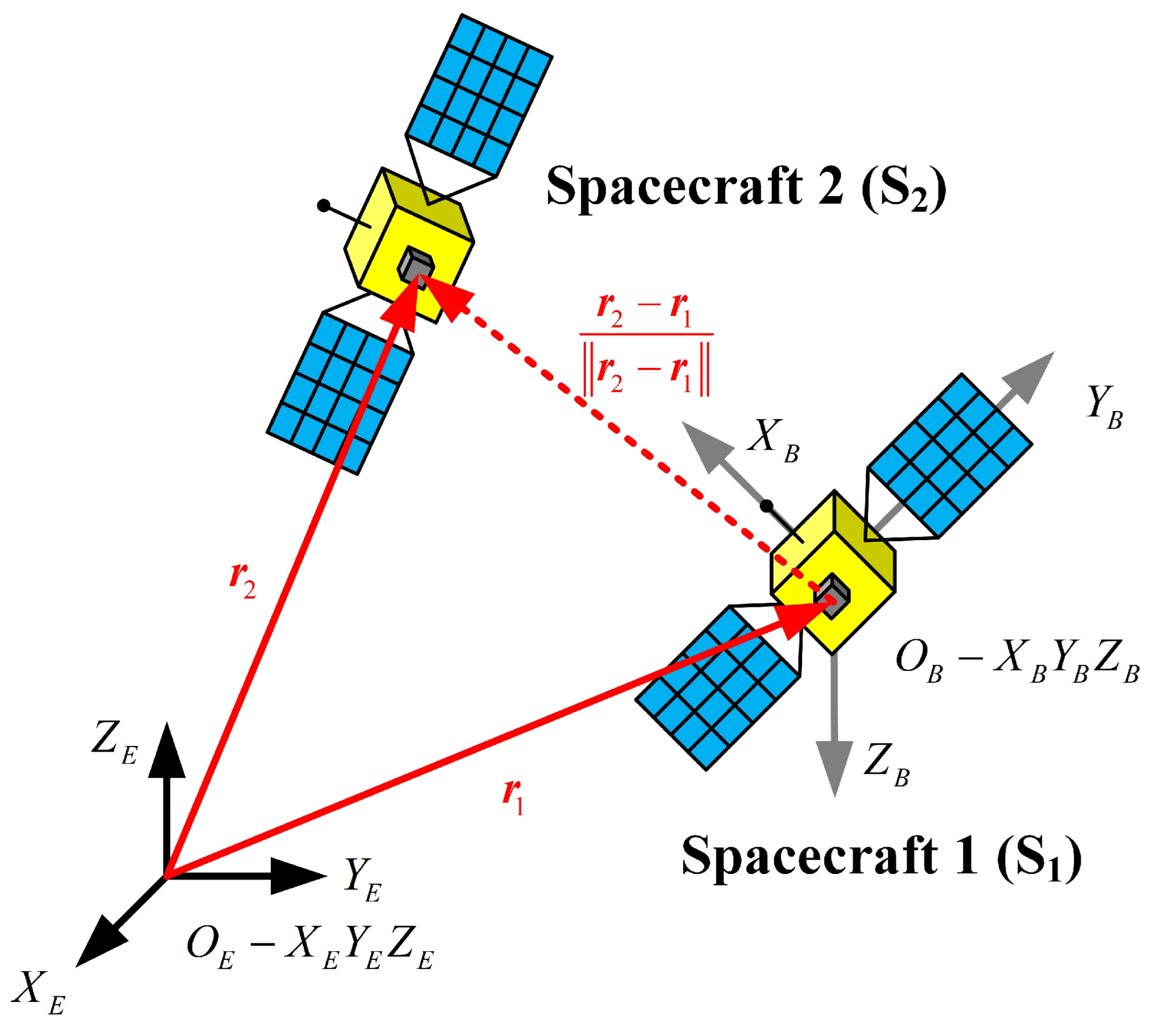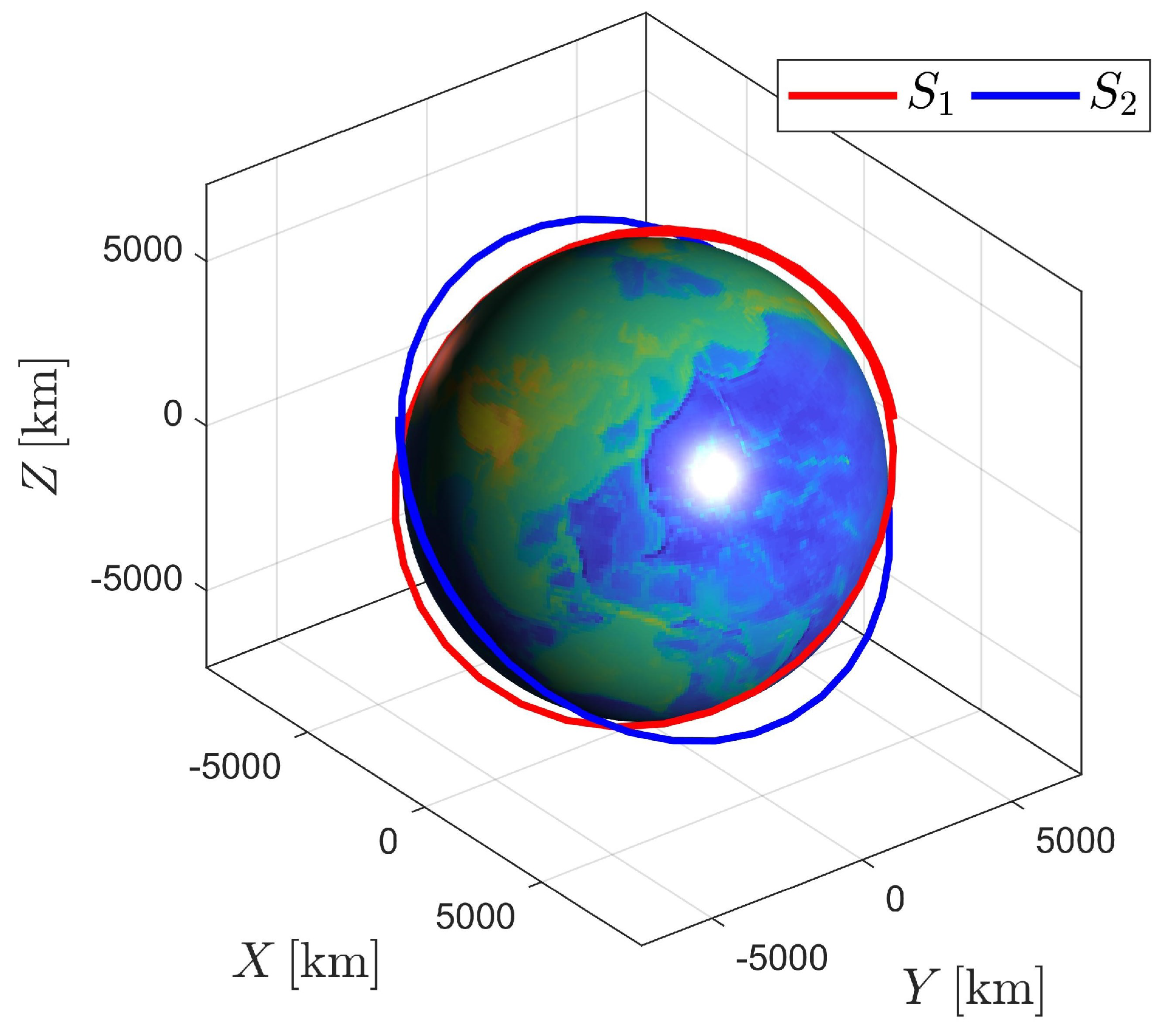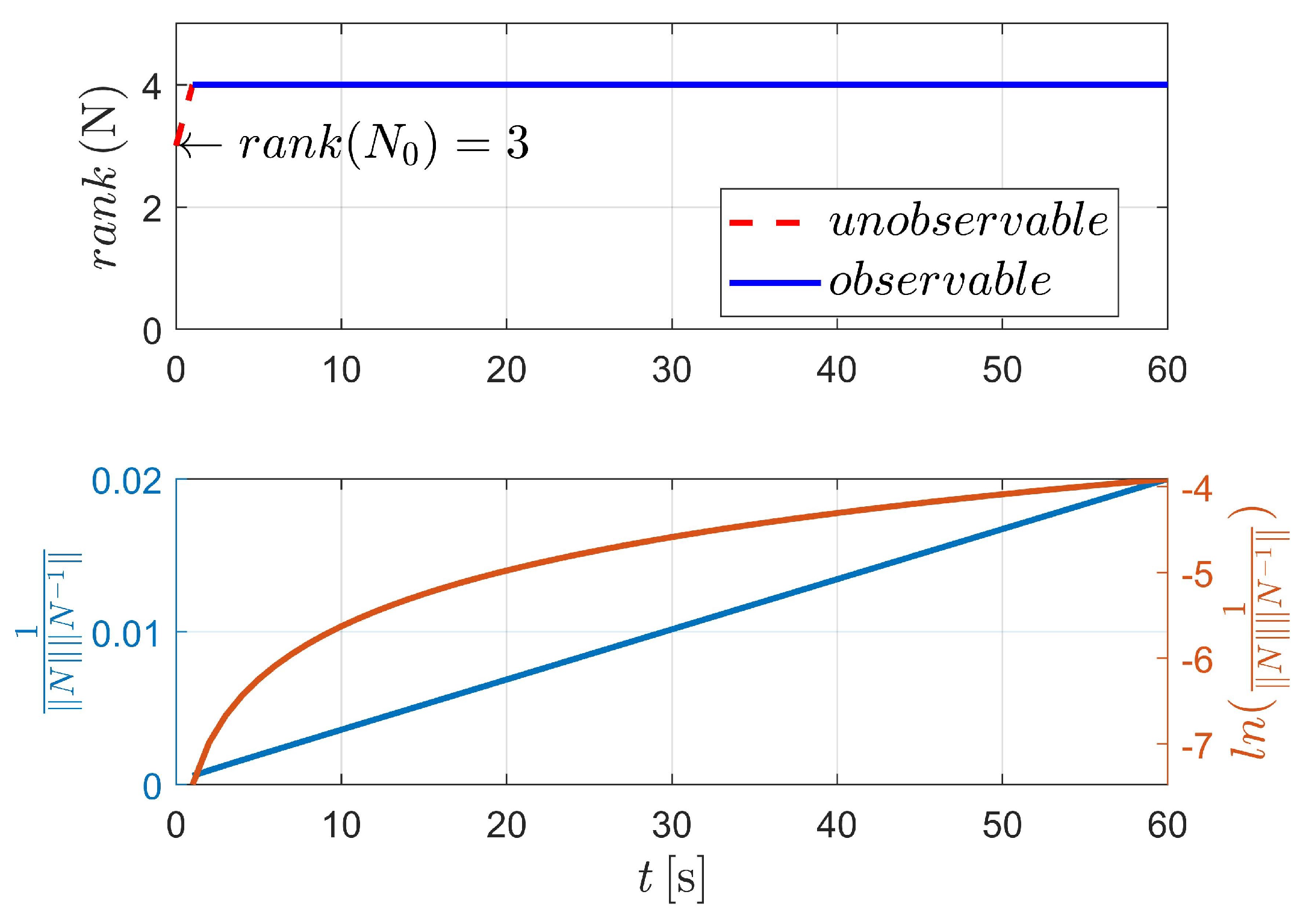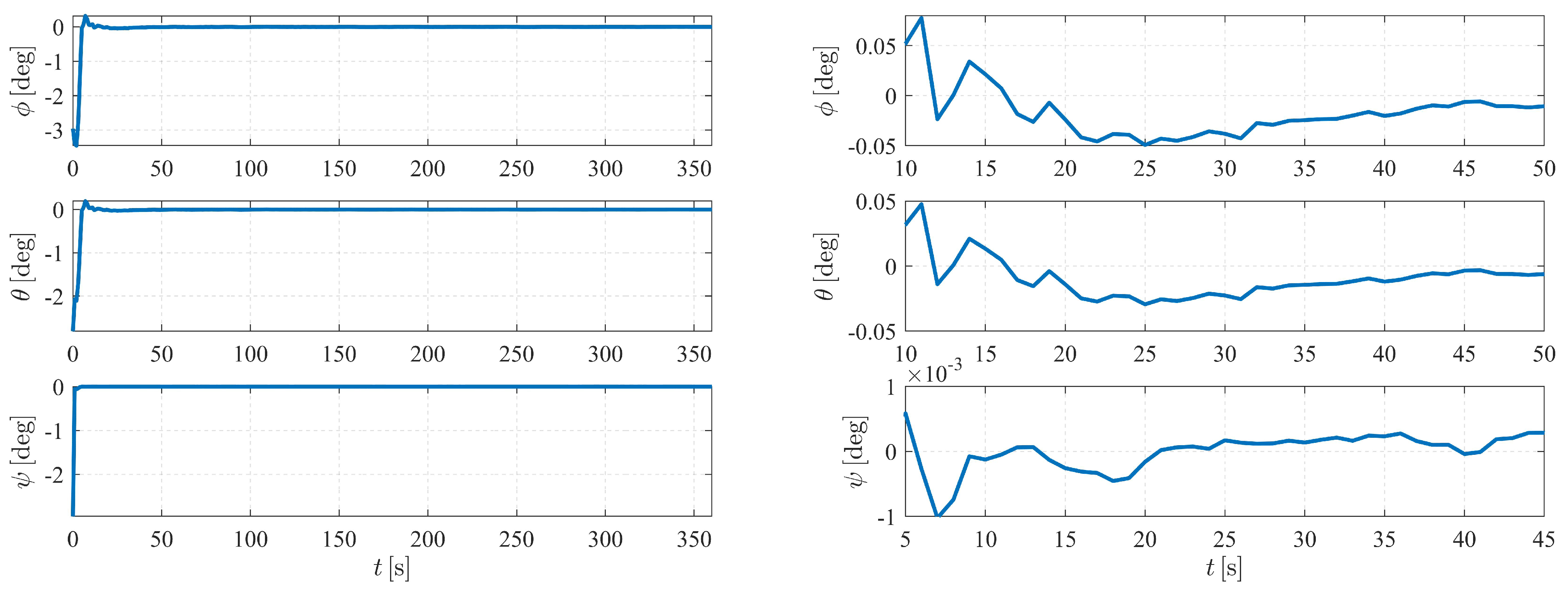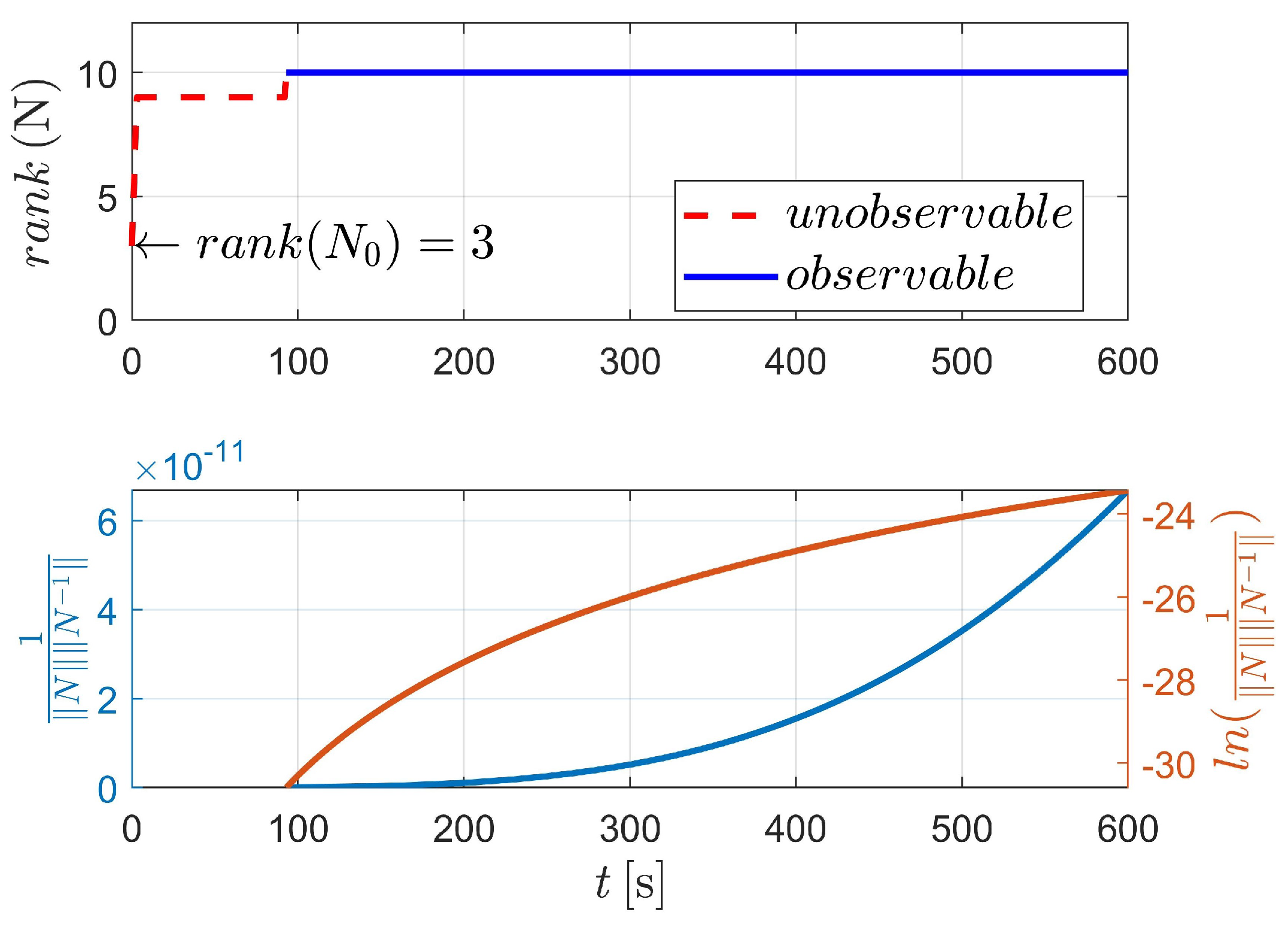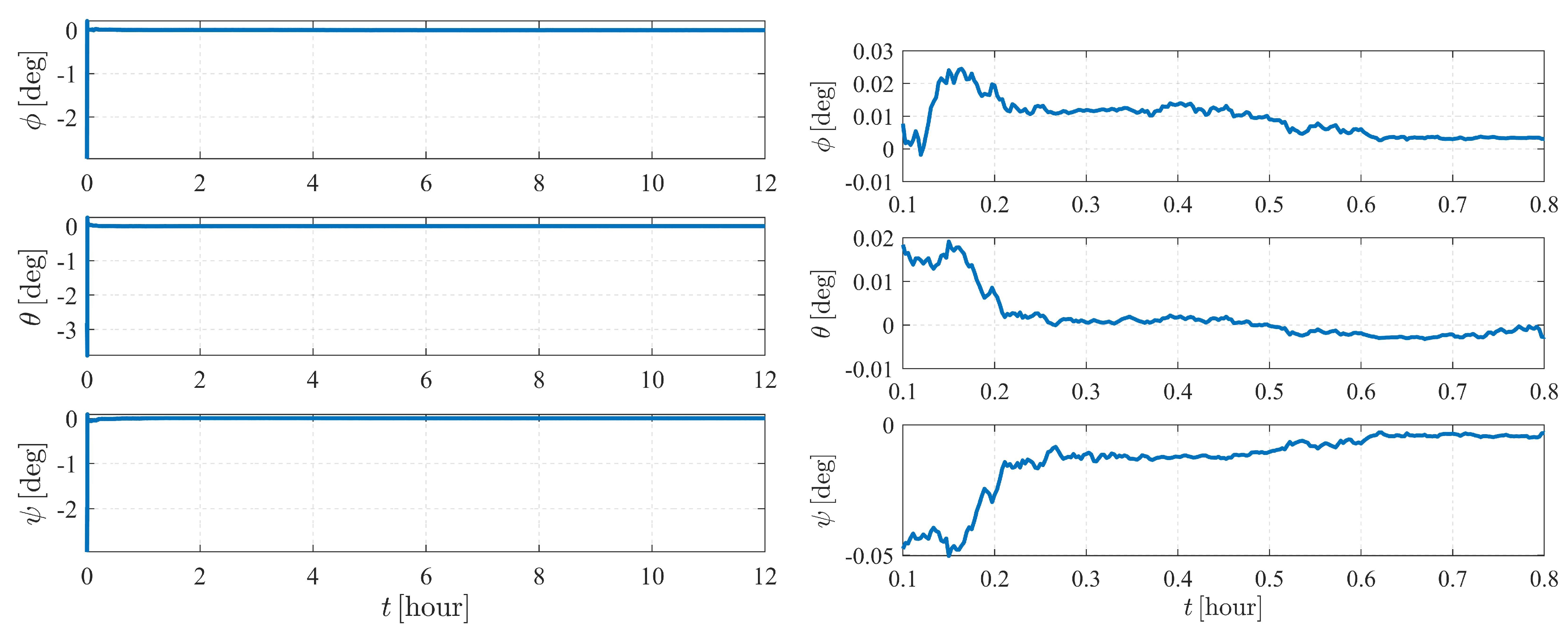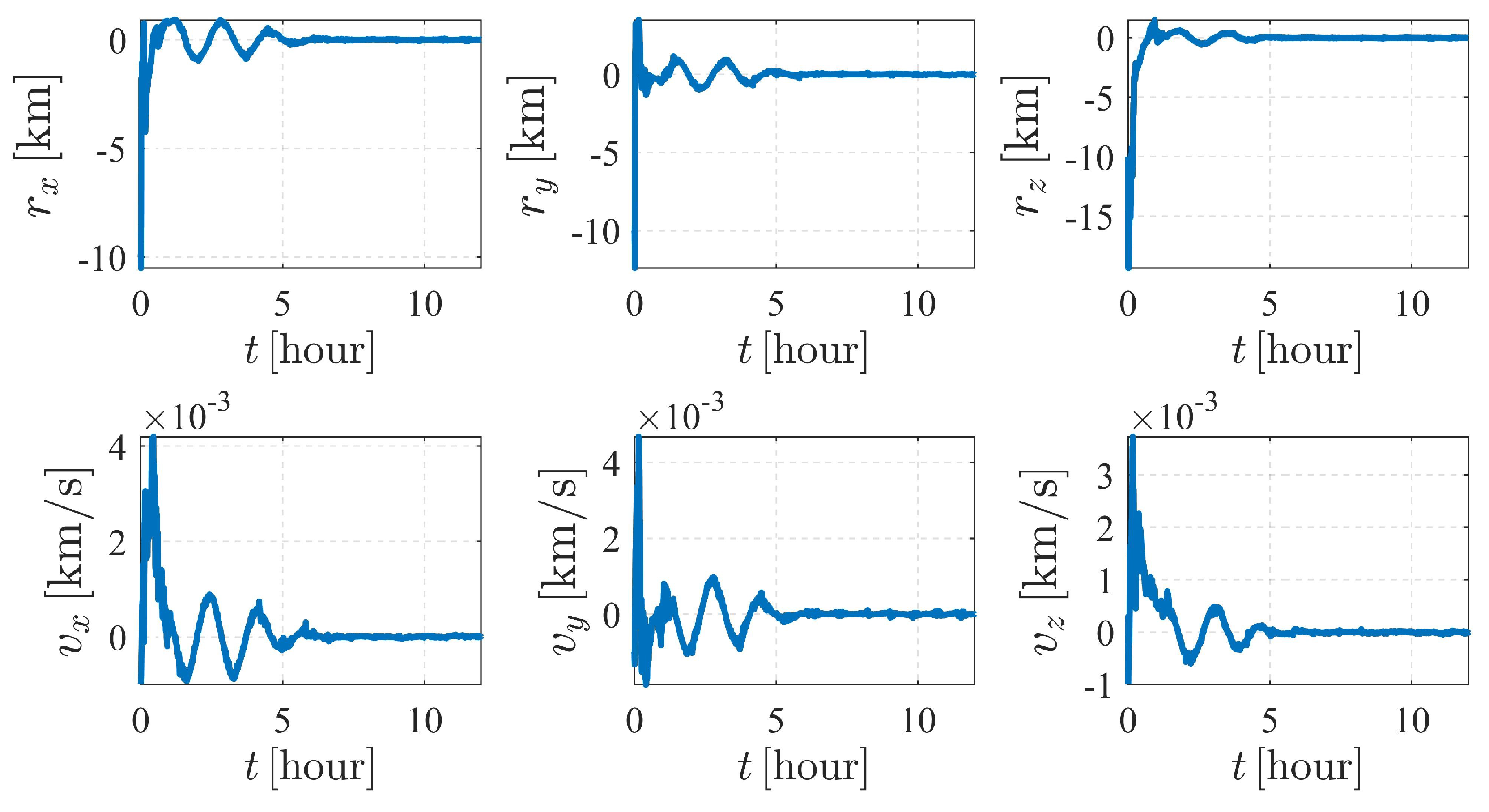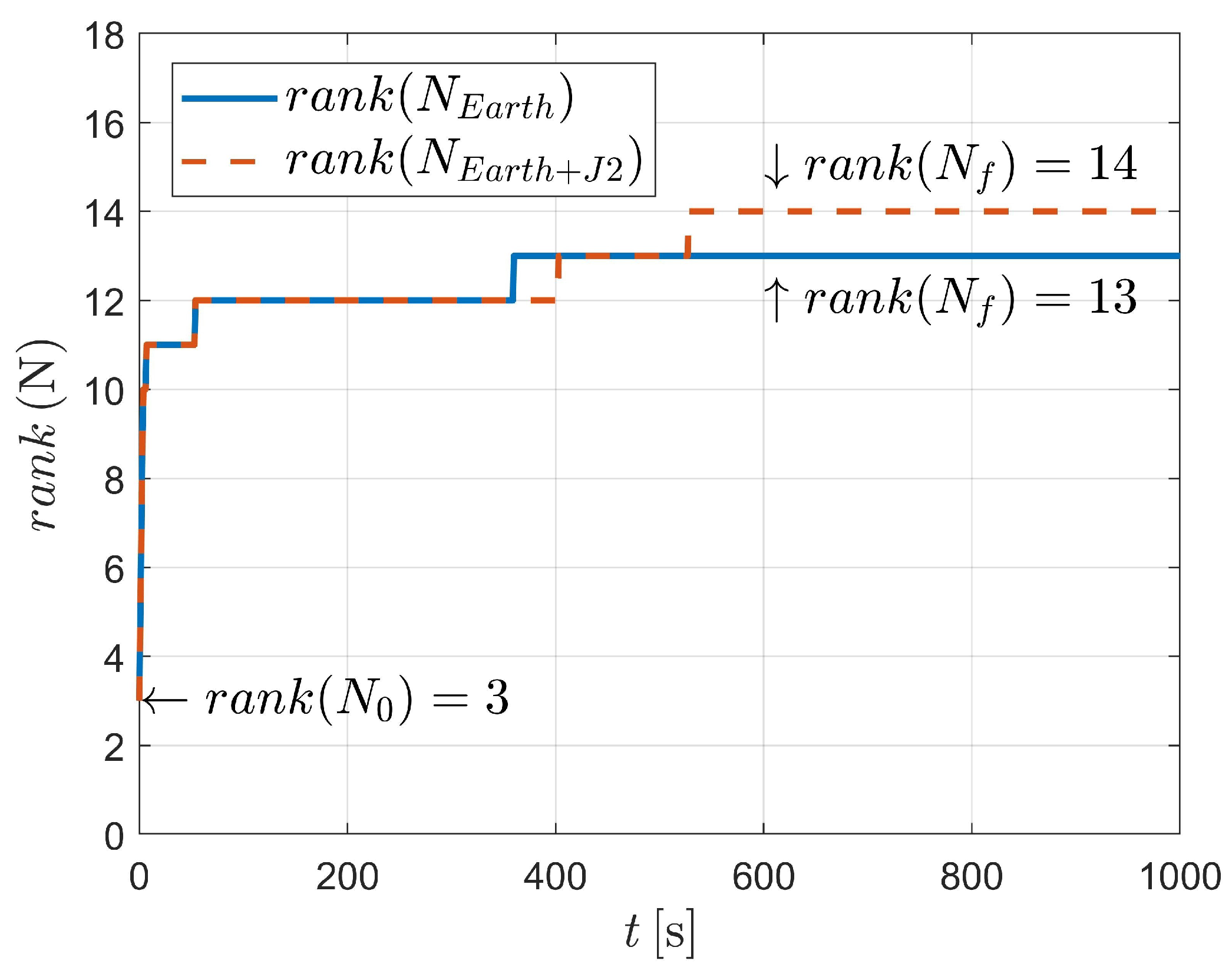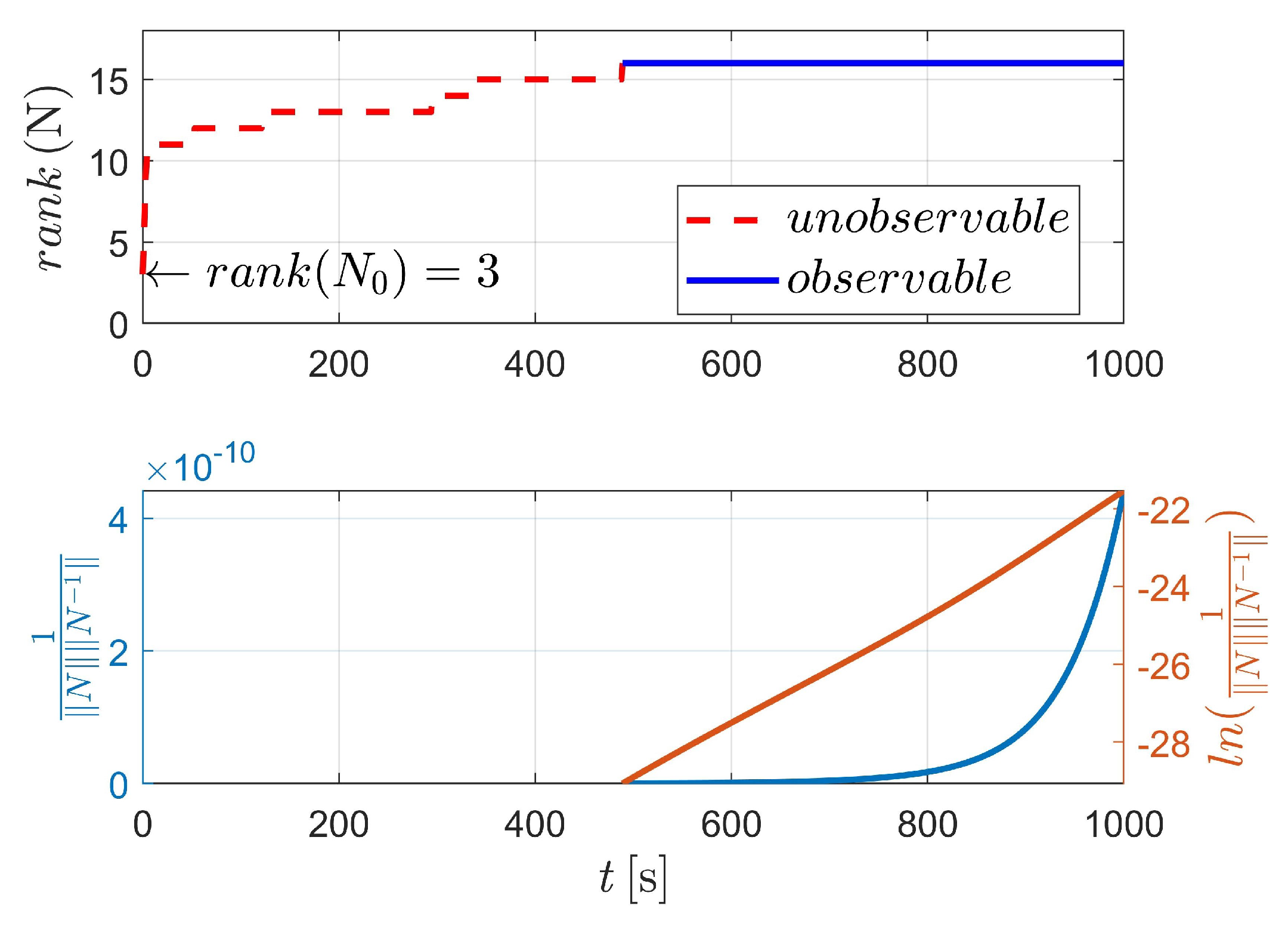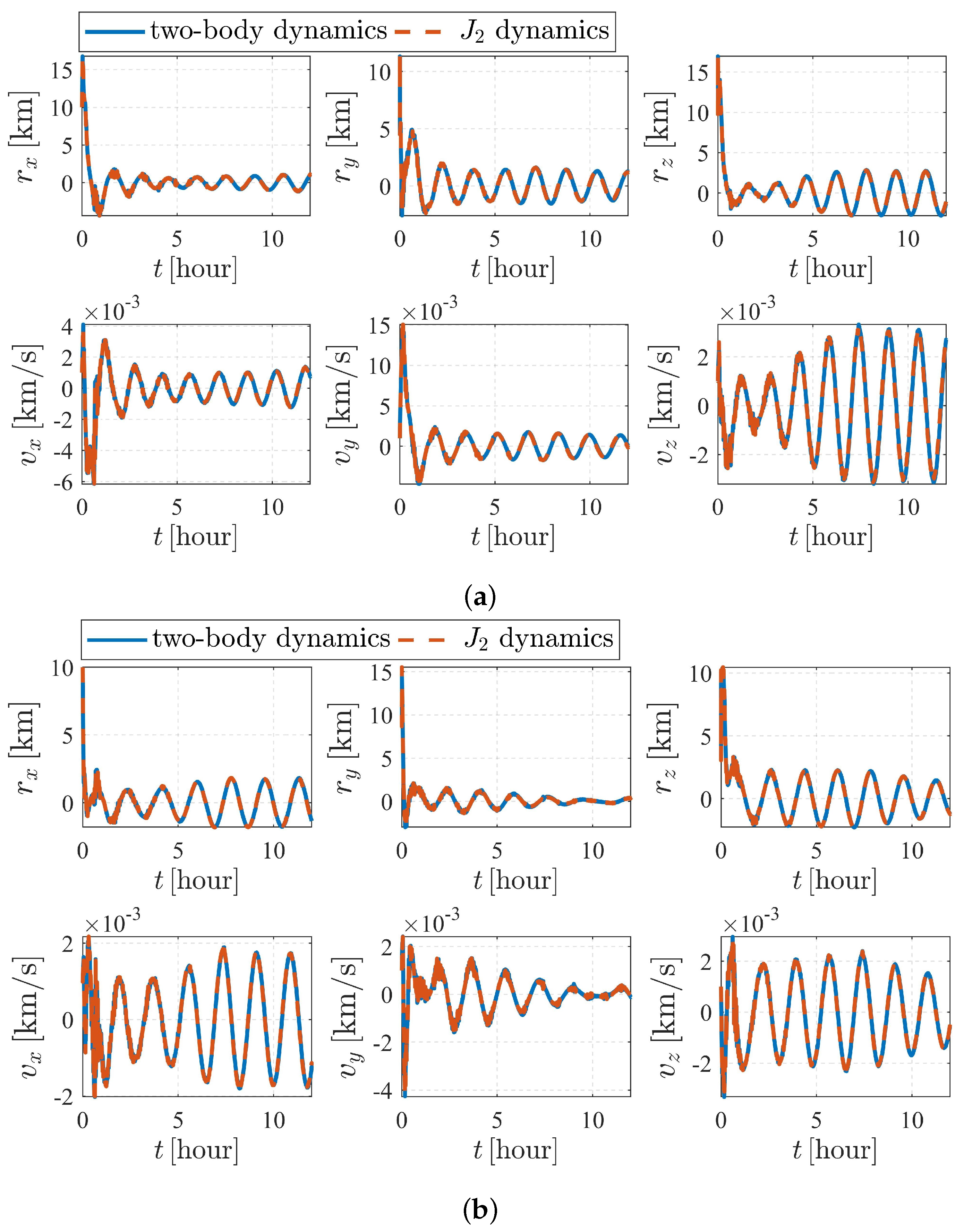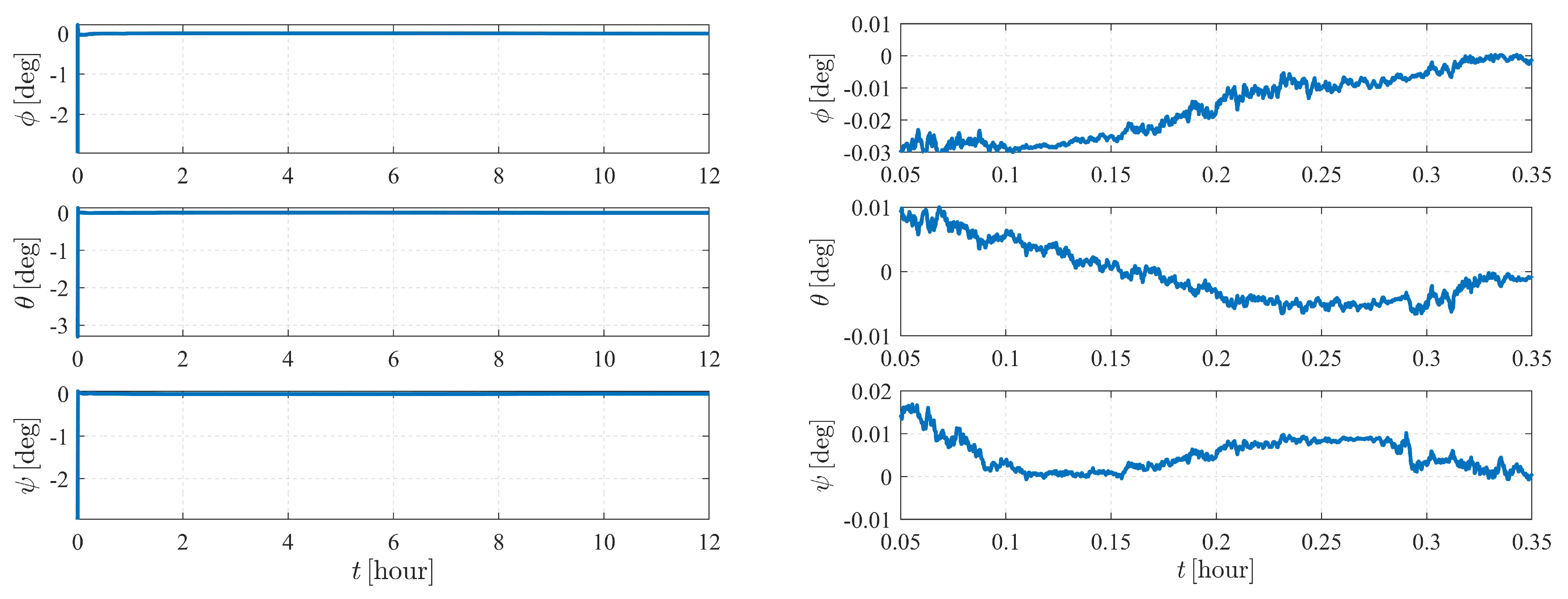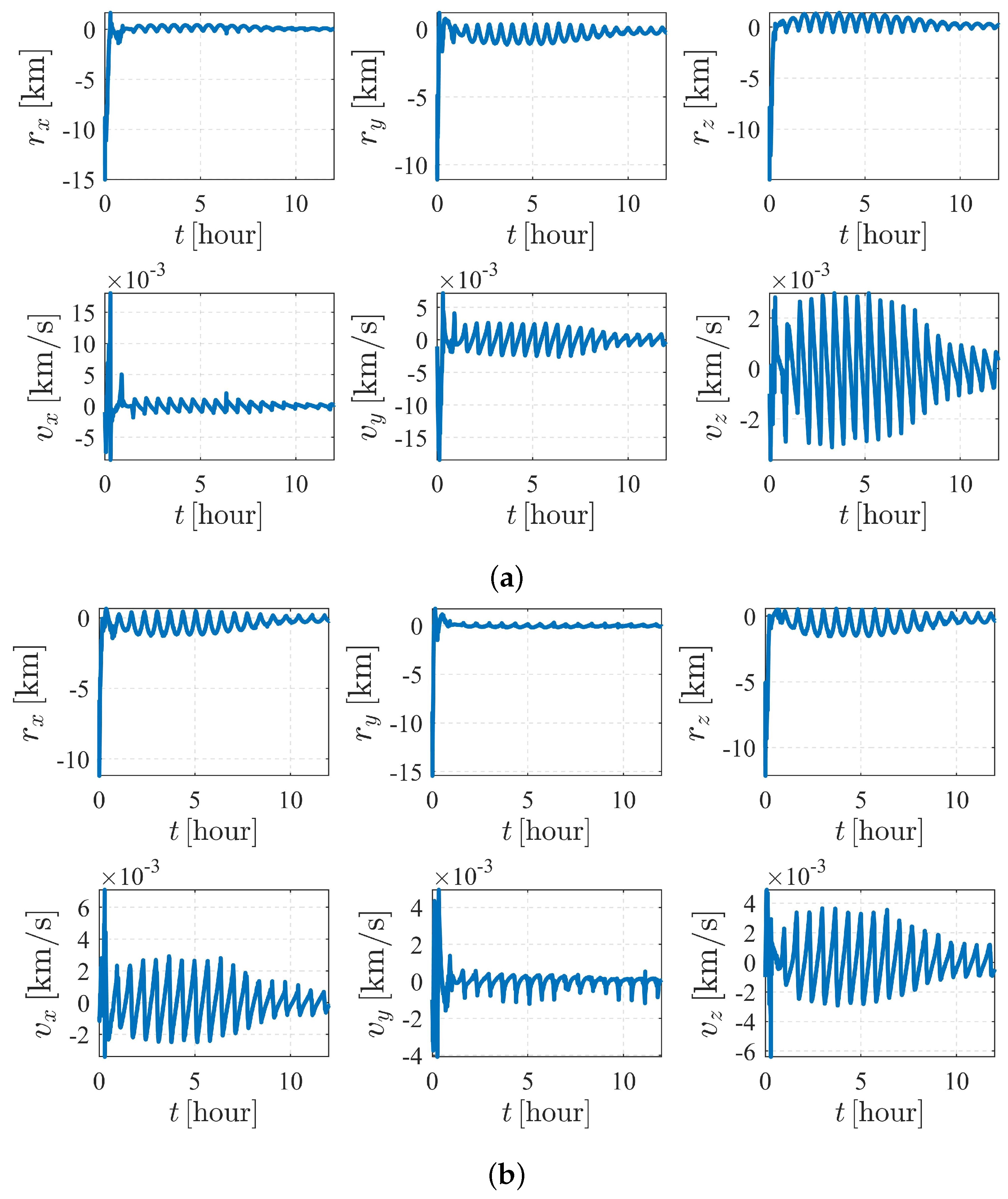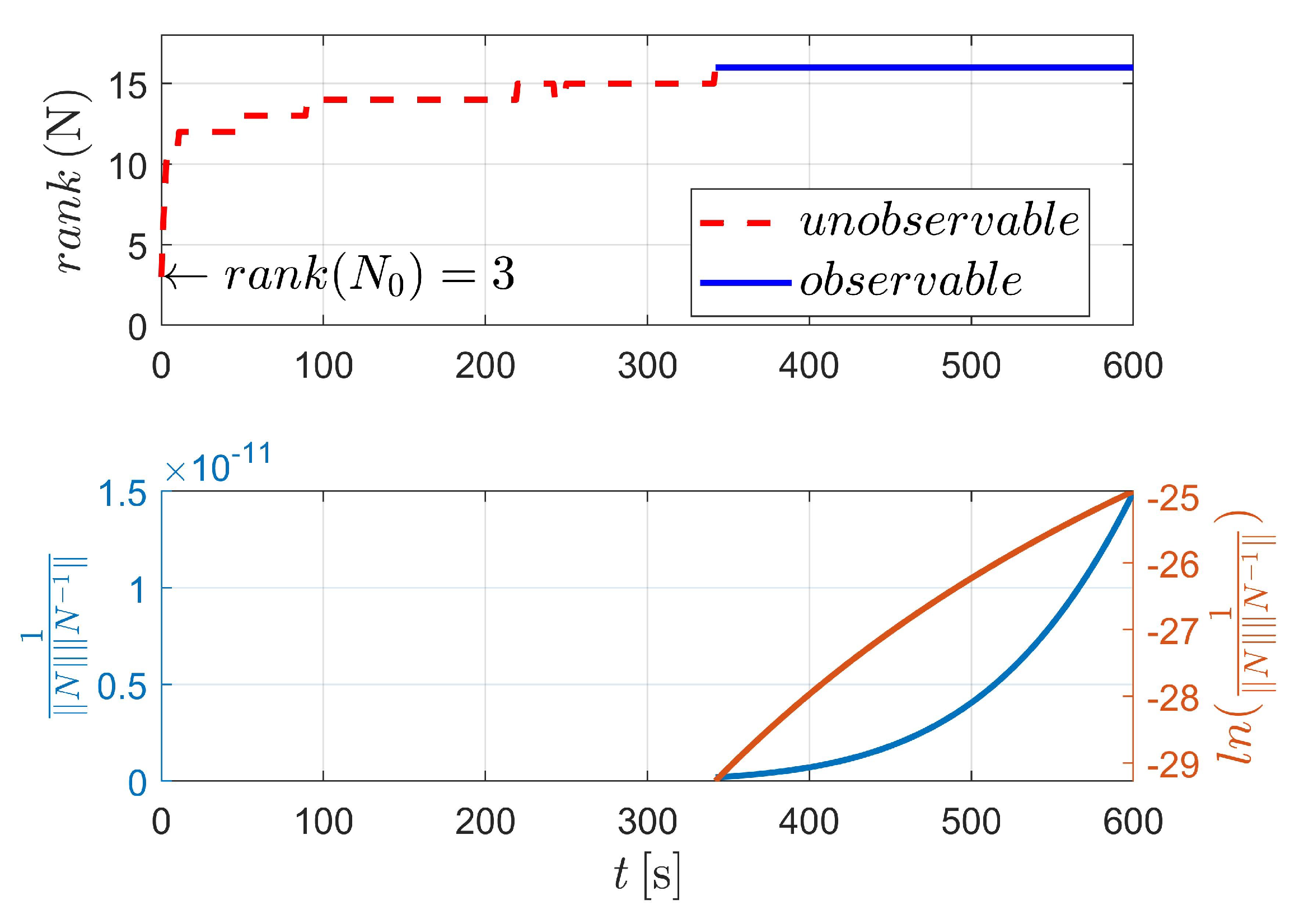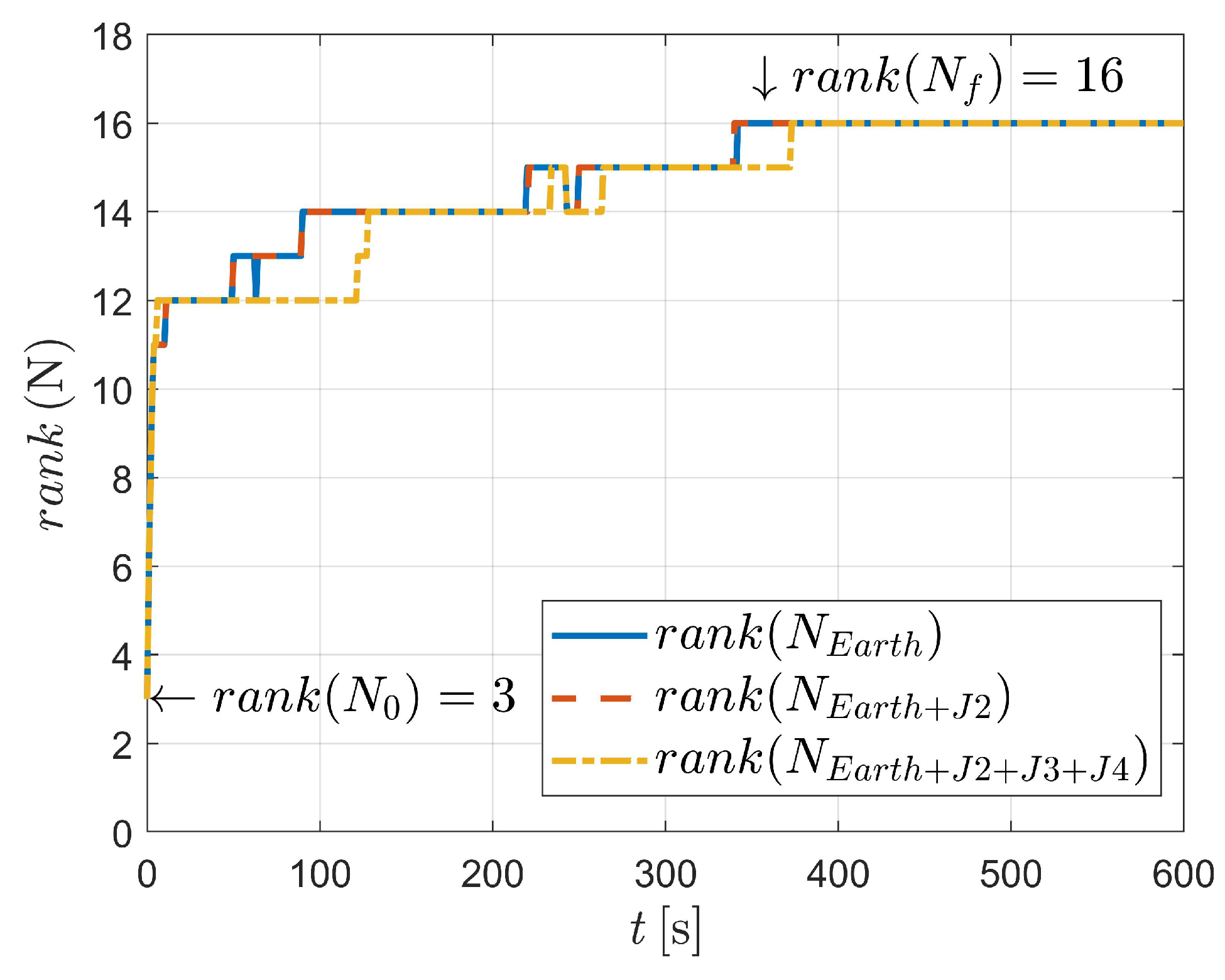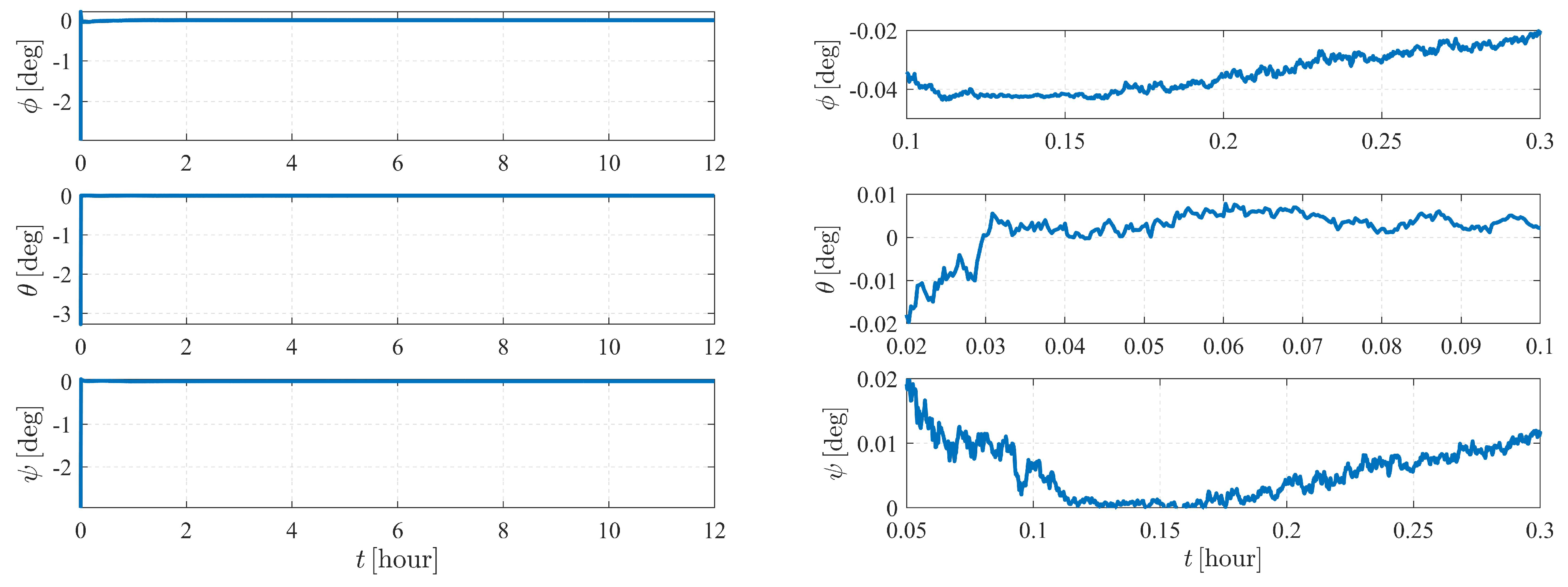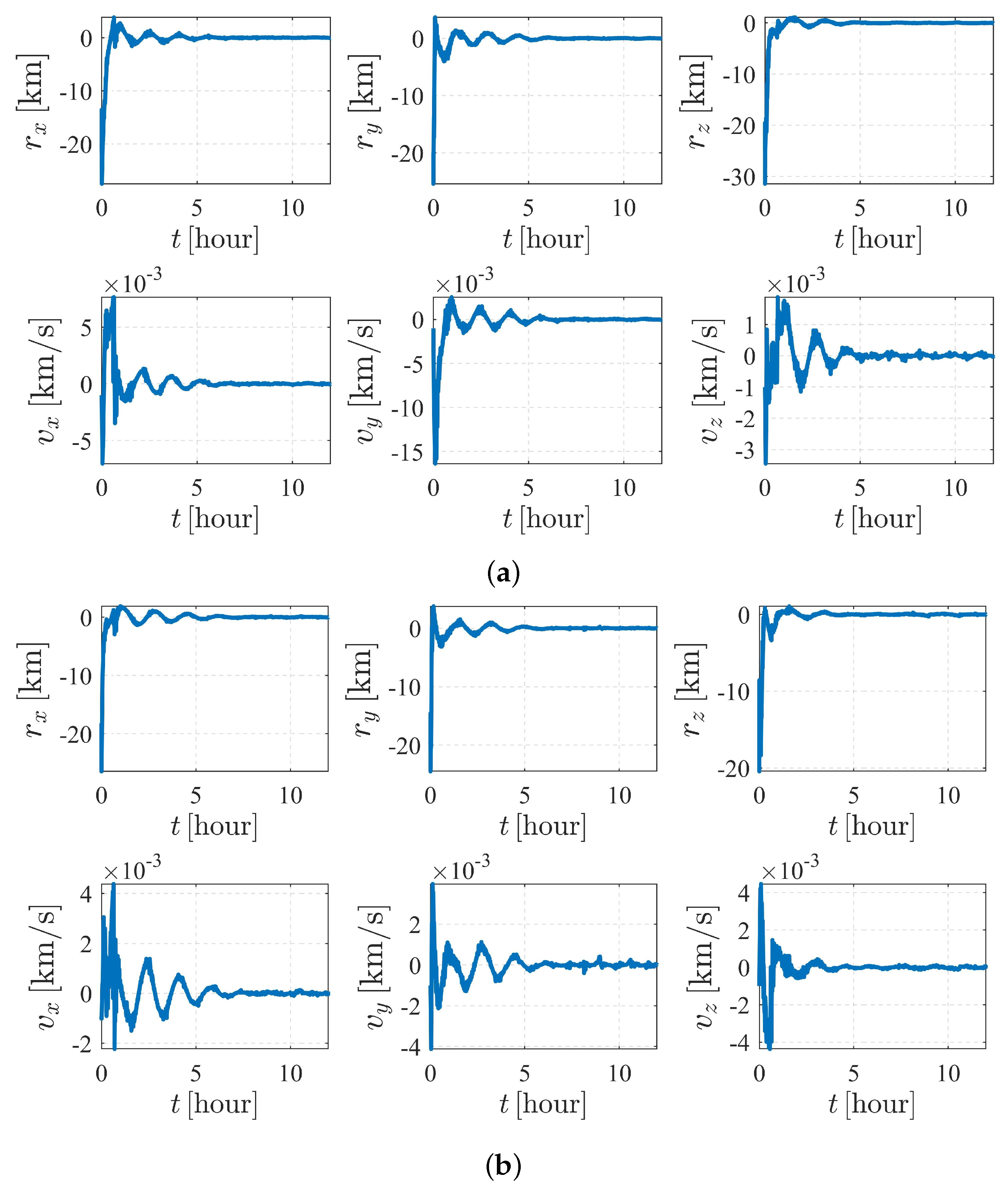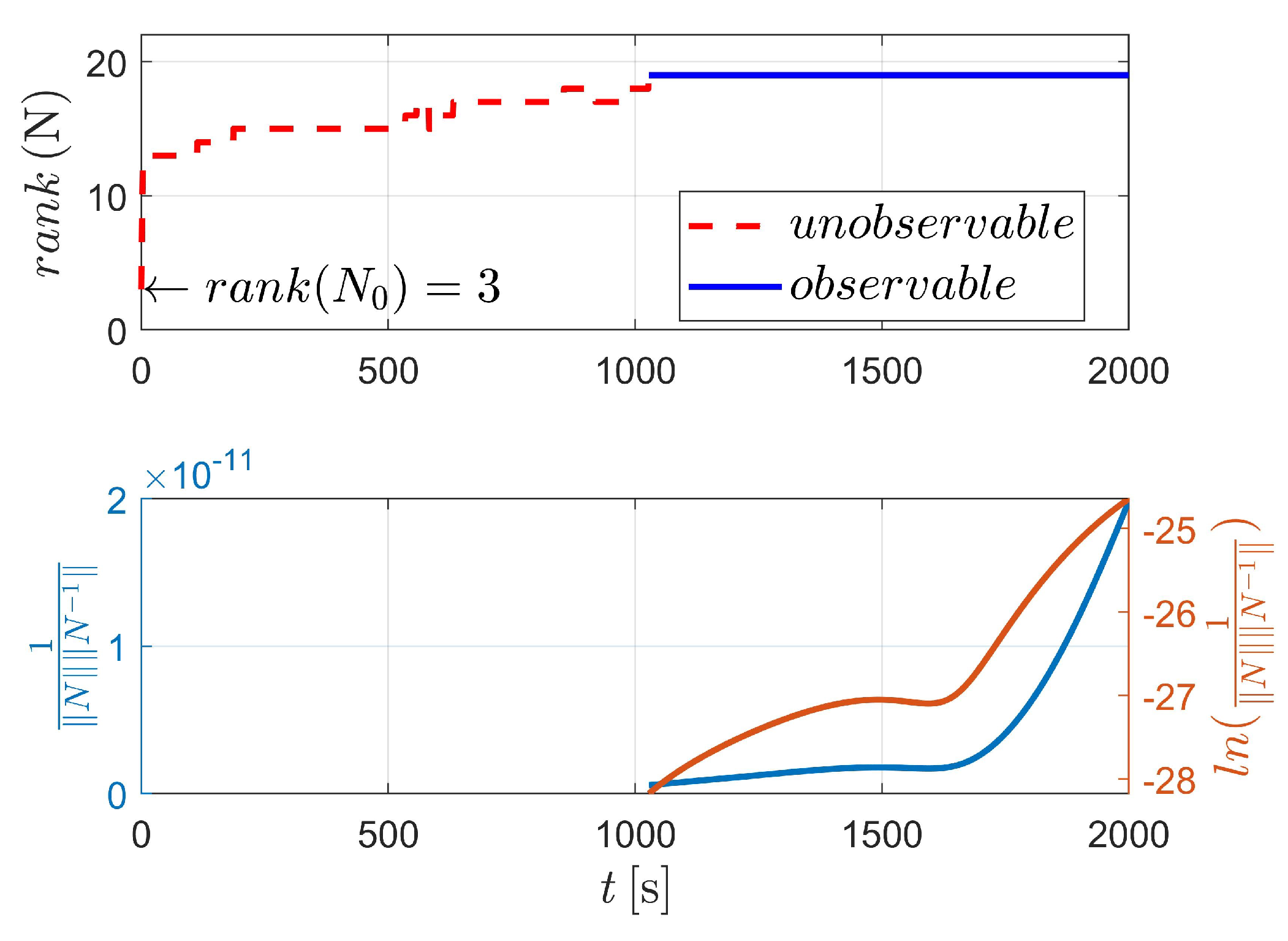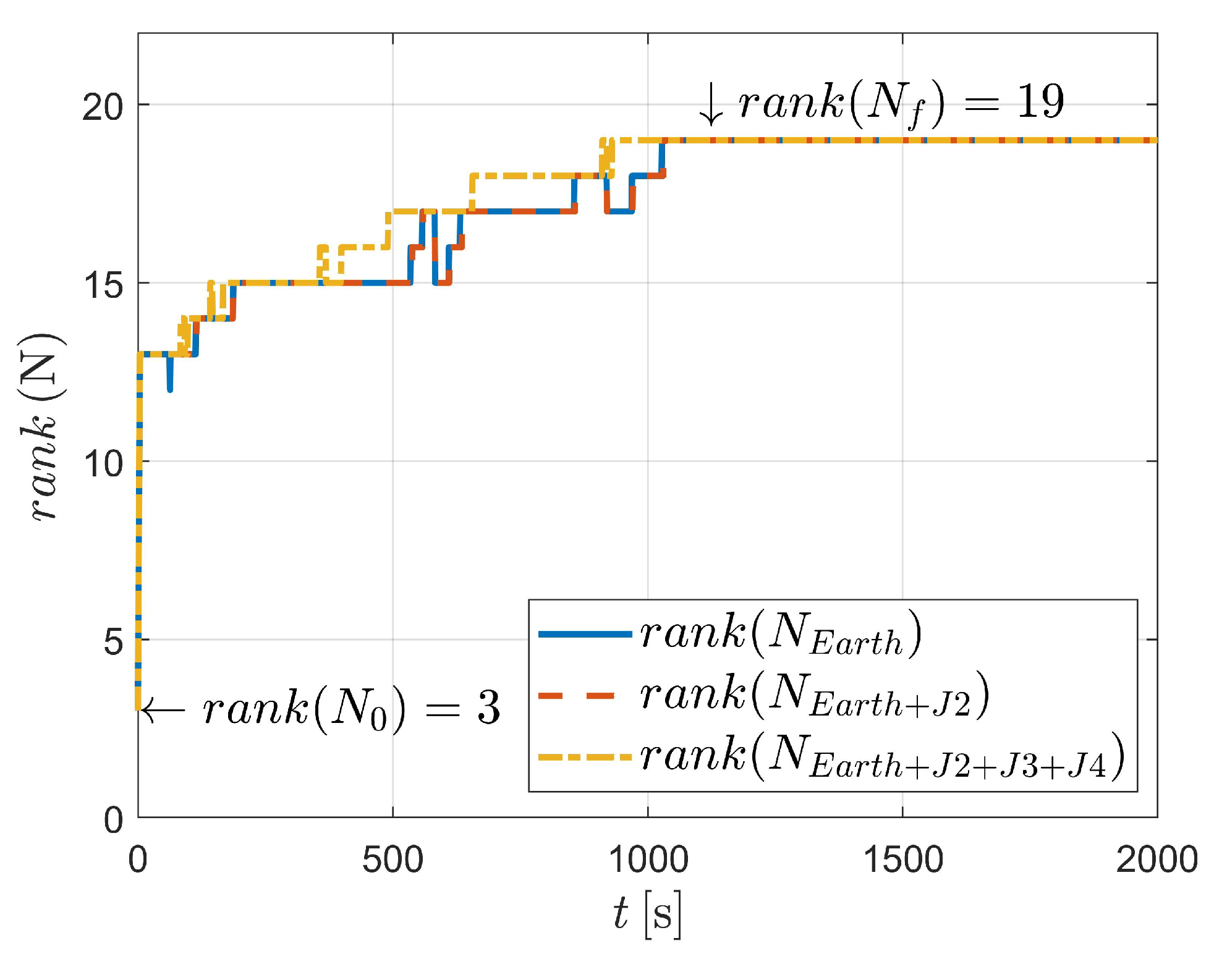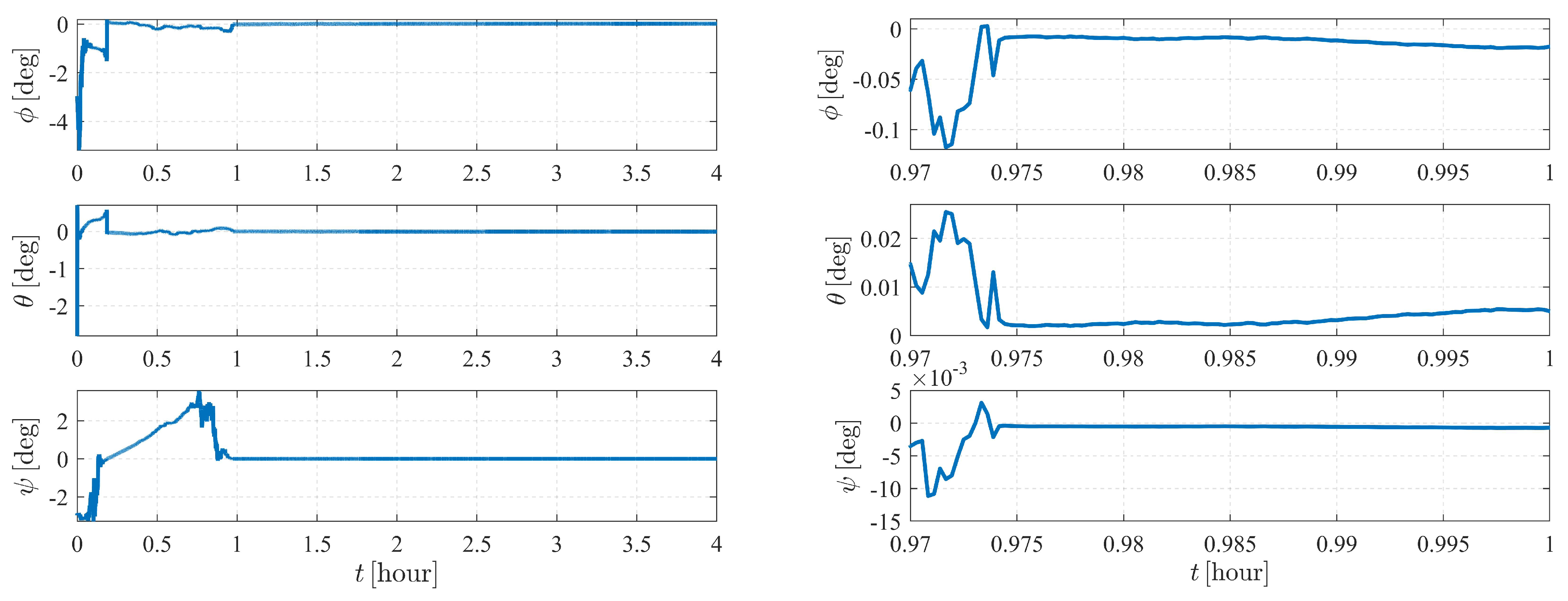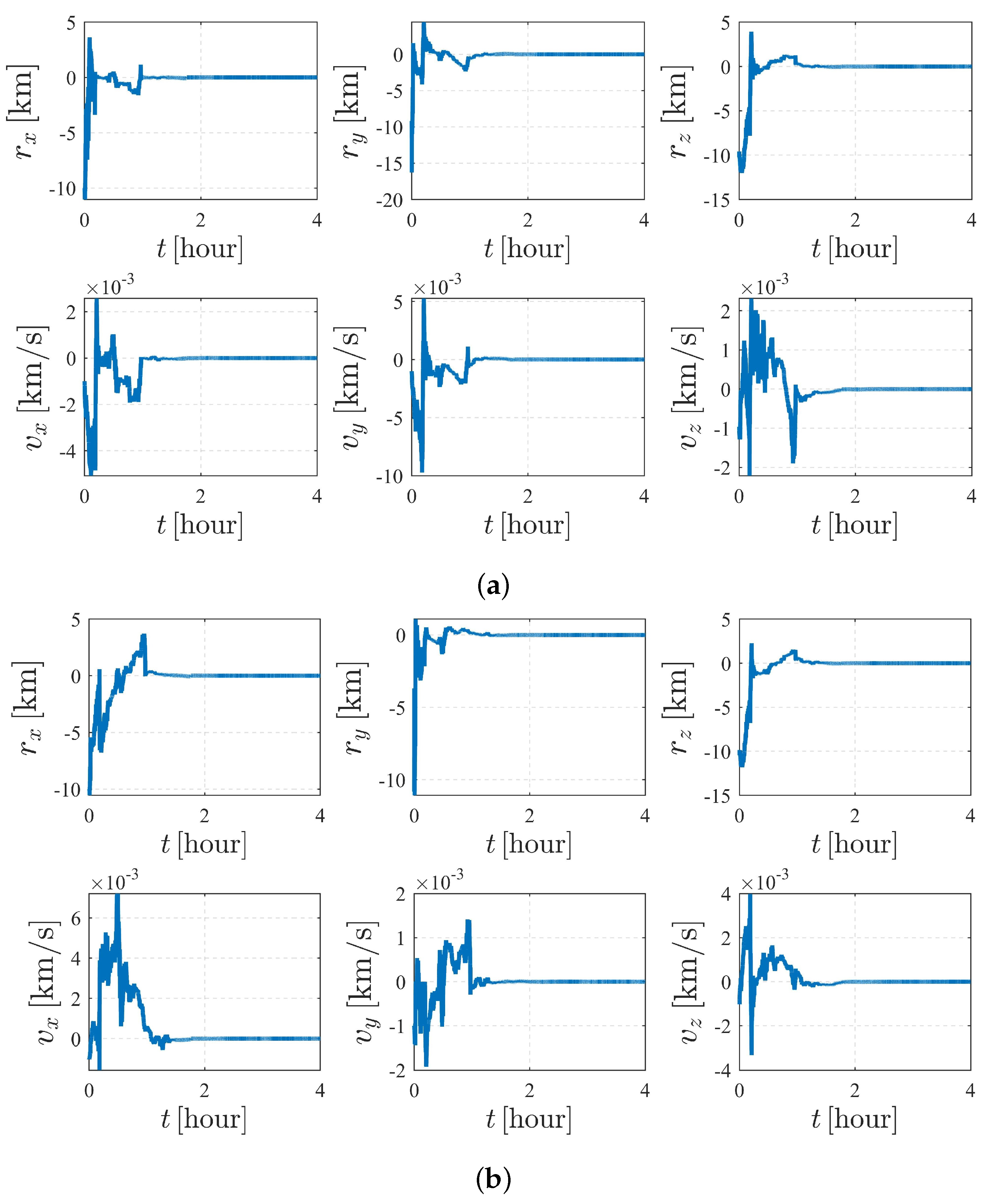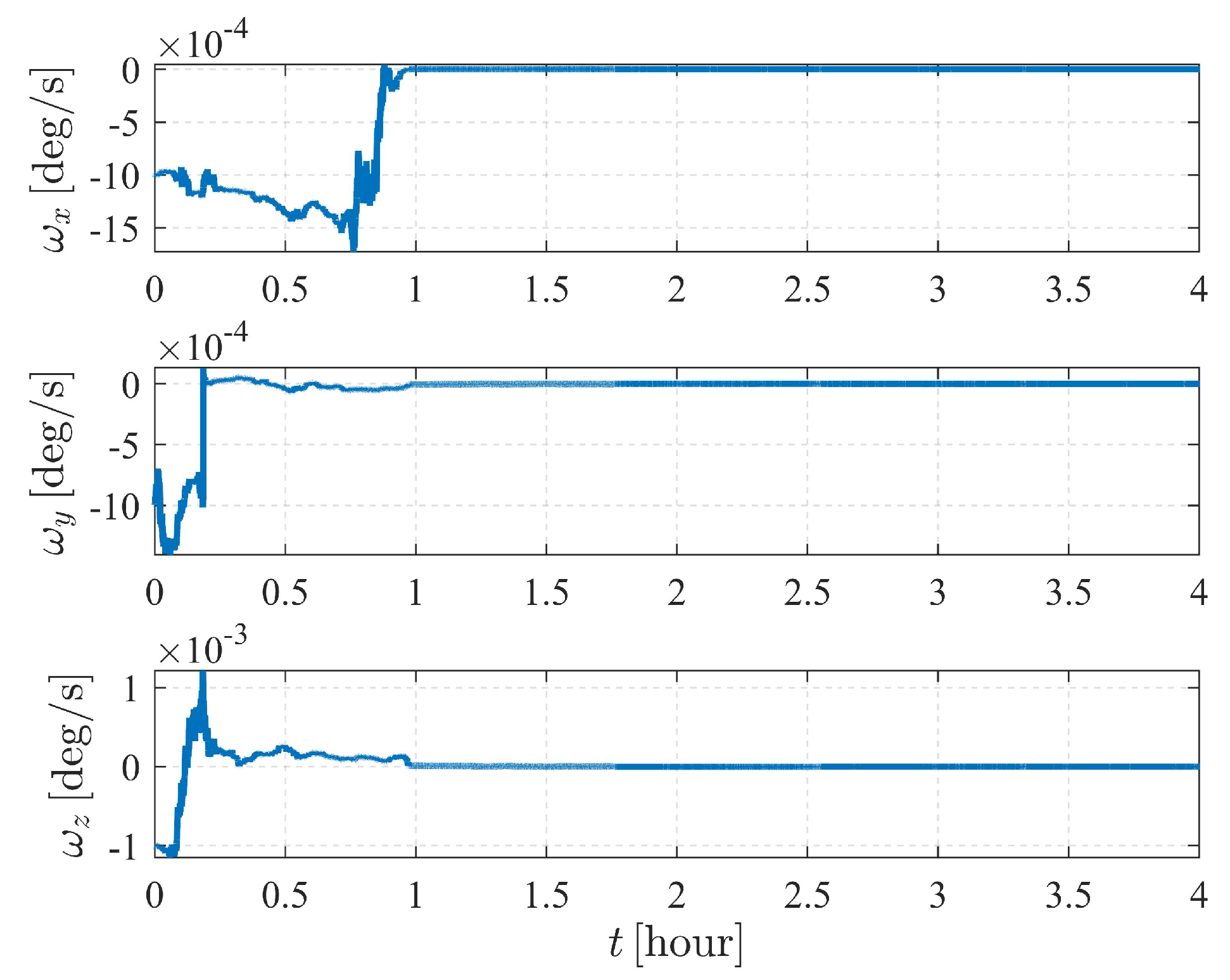1. Introduction
Autonomous orbit determination (OD), due to its considerable value in space systems engineering, has been of widespread interest in the last several decades [
1,
2,
3,
4]. The ability of spacecraft to determine their own states, without the help of ground-based tracking equipment, can improve their ‘intelligence’ and survivability and may also reduce operational management costs [
5,
6,
7,
8]. With the current plans and development of future multispacecraft constellations, the latter issue, i.e., efficient constellation management, becomes particularly important, and autonomous OD for a spacecraft constellation is highly desirable [
9,
10,
11].
Filter algorithms have been widely used in many OD applications since R.E. Kalman proposed his famous recursive method Kalman filter (KF) to solve discrete linear filtering problems in 1960 [
12,
13,
14]. Those filter algorithms could utilize the provided measurements coming from different sensors to obtain the required estimates of the orbit states [
15,
16,
17,
18]. Thus, current filter algorithms rely on the accurate measurement information measured by different sensors equipped on the spacecraft. In this situation, many filter-based methods have been proposed to solve the autonomous OD problem for a single spacecraft using GPS, radar, guidepost and magnetic field vector measurements [
19,
20,
21,
22]. Although the above methods have been proven to be efficient in providing considerable estimation, these measurements rely on complicated measurement equipment, which is impossible for constellation spacecraft.
Recently, a variety of methods have been proposed to solve the autonomous OD problem for a satellite constellation by using only interspacecraft relative measurements [
23,
24,
25,
26]. However, they all face the rank deficiency, meaning that the multispacecraft system with interspacecraft measurements alone is unobservable [
27]. Interspacecraft ranging systems are widely used to obtain range-only measurements between two spacecraft, but they lack observability in some specific situations [
23]. It has been concluded that in the multibody system, due to the nonsymmetric gravity from the noncentral gravitational body, all the orbit elements of two spacecraft can be obtained using only intersatellite range measurements [
28,
29]. However, intersatellite range measurements are not adequate to obtain all orbit elements in two-body dynamics because the rotation of the orbits with respect to the inertial reference system cannot be determined, and only the shape, size, and relative orientation of two orbits can be obtained using only intersatellite range measurements.
Another well-known method employs onboard cameras to obtain the relative angle measurements, which only include the relative direction information [
24,
25]. The angle-only navigation is simple, robust, and well proven in many applications [
30]. However, the inertial states of the spacecraft cannot be observed without additional measurements. At least one beacon (usually noted as attitude-reference spacecraft) must be added to the system to ensure that there is a reference in inertial space or that other sources of measurements should be added [
31]. The basic requirement for orbit determination using angle-only measurements is that the line-of-sight vector must be measured with respect to the inertial frame, which requires several types of sensors, such as a laser sensor to measure the relative range, an optical camera to measure the relative direction, and a star sensor to measure the inertial attitude [
24,
25,
32]. However, due to the size, mass, and power consumption problem of active sensors such as star sensors, they might be unable to be on-boarded for small and microspacecraft to estimate the inertial attitude. Therefore, the inertial attitude of observing spacecraft should also be added into the OD problem when using intersatellite line-of-sight angle measurements. Fortunately, the conclusion of OD using angle-only measurements in two-body dynamics does not hold in other dynamical cases. Specifically, the obtainable orbit elements deviate from the prior conclusion under a more complex dynamic. For example, perturbations affect the orbits and contribute to deviations of real orbits from ideal two-body dynamics, which may improve the observability of a system. Moreover, with a calibrated thrust maneuver, observability can be guaranteed for possible situations [
33].
Observability analysis is necessary to determine whether a particular measurement system is sufficient to solve the state estimation problem [
34,
35,
36], and a number of researchers have carried out this analysis in the context of the OD problem [
37,
38,
39]. One unwieldy approach to establish observability is to use classical nonlinear techniques that rely on Lie-derivative criterion methods [
24,
25]. In general, it is difficult to provide further results on the system observability based on the Lie derivative criterion because the analytical expressions of higher-order Lie derivatives become progressively more complicated. Hence, discussing observability for nonlinear systems using Lie algebra and differential geometry methods becomes quite difficult. Another type of approach for establishing observability is the observability matrix (OM) [
1,
11]. The OM method can be used to determine whether a system can be observed using sequential measurements, which are easy to obtain through numerical propagation.
In this paper, a novel concept for autonomous OD is proposed based on a two-spacecraft system with angle-only measurements. Differently from the traditional autonomous OD using intersatellite angle measurements, the inertial attitude of the observer is also added to be estimated. In this manuscript, we present for the first time the observability analysis and the orbit estimation results for a two-spacecraft system with different additional conditions. Five conditions are considered and for each condition, the observability of the OD system is investigated using the OM.
The remainder of this paper is organized as follows. The state model and the measurement model used is firstly presented in
Section 2, followed by brief reviews of the OM and the fifth-order CKF. Five conditions, as well as the corresponding OMs, are discussed in
Section 3. The observability analysis and filter estimation results are shown in
Section 4. Finally, conclusions are given in
Section 5.
4. Numerical Simulation
In this section, a series of numerical results for several types of scenarios is presented, with the following three objectives: (1) to demonstrate whether the system is observable or unobservable for each scenario and (2) to validate the observability indices by comparing their estimations to the quality of the solution of the state estimation problem using the fifth-order CKF.
4.1. Simulation Background
An example with two spacecraft in circle orbits is considered. The nominal orbit elements are listed in
Table 1, and the corresponding orbits are shown in
Figure 2. The elements
h,
e,
i,
,
, and
n denote the orbit altitude, eccentricity, inclination, longitude of the ascending node, and argument of the periapse and true anomaly, respectively. The semimajor axis a is computed by
, where
is the radius of the Earth.
The initial position and velocity errors (if unknown) are set to 10 km and 10
km/s, respectively. The initial attitude of spacecraft
is set to be
and
. For all the cases above, the initial estimation of the quaternion is given by:
where
.
The initial angular velocity of spacecraft , if existing (i.e., for case IV and case V), is set to be . The initial estimation of angular velocity is considered as if is to be estimated (only for case V).
The initial covariance matrix is given as , , , and .
Suppose spacecraft
could track
using optical equipment, where possible, with a 1 s measurement. The angle-measurement error in Equation (
17) is assumed to be Gaussian white noise with a standard deviation (STD) of
(equal to
).
4.2. Results and Discussion
During the observability test, the state transfer matrix is obtained using MATLAB function ode45, the rank of OM
is calculated using function rank and the CN of the system
is obtained by function cond. All the following operations are executed on MATLAB R2018b [
40]. In addition, the particular situations for the autonomous attitude and orbit determination with two spacecraft are simulated to verify the observability analysis. The nominal orbit elements are given in
Table 1. The estimation problems are solved using the traditional fifth-order CKF. For convenience, the quaternion of spacecraft
is transferred into the form of Euler angles using the MATLAB function quat2angle. The results are given as follows.
4.2.1. Case I: Both Orbits of and Are Known, and the Attitude of Is Unchanged
Figure 3 displays the observability results of case I, using the two-body dynamics (state model as Equation (
3)). For case I, 60 measurements (equivalent to 60 s) are executed during the navigation process. As shown in
Figure 3, the upper stacked subplot illustrates the rank of the observability matrix (OM), where the red line represents the unobservable period (i.e.,
) and the blue line represents the observable period (i.e.,
). Moreover, the lower stacked subplot demonstrates the condition number (CN) of OM (note that in
Figure 3, the y-label represents the reciprocal of CN). In addition, the logarithmic value of the reciprocal of CN is also given in the lower stacked subplot, making the change curve of CN more obvious.
Figure 3 shows that the CN deceases with respect to the observation time, which means that the observability of the system continuously improves as the number of measurements increases.
The detailed value of the corresponding index in
Figure 3 is selectively illustrated in
Table 2. For case I, the system is completely observable after only two measurements (at epochs
and
, respectively).
Figure 4 depicts the estimation errors of the attitude of spacecraft
. It is shown that the errors converge to zero at approximately 50 s when the initial Euler angle errors are set to be
.
4.2.2. Case II: The Orbit of Is Known, and the Attitude of Is Unchanged
The observability results of case II are illustrated in
Figure 5 and
Table 3. As indicated in
Figure 4, the system of Equation (
39) is observable after approximately 94 measurements (from epoch
to epoch
). Compared with case I, the system corresponding to case II is much more difficult to observe. Note that as containing the state vector of target spacecraft
, the dimension of the state to be estimated in case II is higher than that of case I, which implies more effort in measurements.
The estimation results are illustrated in
Figure 6 and
Figure 7. As shown in
Figure 6, the attitude converges much faster than the orbit state, as the previous item converges within only a few minutes, while it takes approximately five hours for the orbit state of spacecraft
to converge. Note that measurement model (
17) is much more sensitive to the attitude of observer
than the orbits of the observer and the target. Therefore, the attitude converges before the orbit state converges. Note that the observation interval has no effect on the observability, so the influence of shadow or light conditions are not considered in this paper. In most cases, the long-term observation in
Figure 6 is impossible to realize due to eclipses, but this simplification is reasonable considering the research content of this paper.
4.2.3. Case III: Both the Orbits of and Are Unknown, and the Attitude of Is Unchanged
In this case, three kinds of dynamics (state model as Equation (
3) and Equation (
4), respectively) are considered, as illustrated in
Figure 8 and
Figure 9. It can be concluded that for dynamics with nonperturbation and
perturbation, the systems are unobservable (as shown in
Figure 8).
For case III, the state vector with 16 variables is estimated. However, when considering two-body dynamics, the observable states are 13-dimensional, which means that only 13 variables (or variable combinations) of the 16-dimensional state vector can be observed. In addition, when taking the perturbation into consideration, one more state variable (or variable combination) could be observed, suggesting that the system is still unobserved.
Fortunately, as depicted in
Figure 6 and
Table 4, the system is observable when
,
and
perturbations are considered. In this situation, a total of 16 variables are observed after 490 angle-only measurements. It should be noted that strictly two-body dynamics, or dynamics with a particular perturbation, are, of course, unlikely. This is because aspheric perturbation of the celestial body (i.e., Earth in this paper) contains higher order terms. Moreover, the solar pressure, atmospheric drag and gravitational perturbation of the third body could also influence the orbiting spacecraft. However, the significance of the observability analysis is to state (as might be expected) that when the dynamics are very close to the two-body dynamics (e.g., when an orbit is high, for example, high-orbit GPS satellites), it is difficult to estimate the orbit because the influence of aspheric perturbation is weak.
The simulation results of the subcase with nonperturbation and
perturbation are illustrated in
Figure 10. It was shown that estimation quality is poor and appears to be diverging (the
for
and
for
are clearly divergent with time), meaning that the system is unobservable under the given dynamics and initial conditions, which validates the observability analysis listed in
Table 4.
Figure 11 and
Figure 12 depict the autonomous attitude and orbit determination results of the two spacecraft considering
,
, and
perturbations. Although exhibiting an obvious oscillation, the system still succeeds in converging. However, compared with the results in case II, the convergence is much weaker, meaning that this form is not stable enough. It is noted that although we have proven that case II under dynamics (5) is observable, this does not contradict the estimation results obtained here but implies that the system is higher-order locally weakly observable [
24].
4.2.4. Case IV: Both the Orbits of and Are Unknown, and the Angular Velocity of Is Known
In case IV, the results are demonstrated in
Figure 13 and
Figure 14 and
Table 5. As shown in
Figure 13 and
Table 5, when applying a known attitude maneuver to observer spacecraft
, the system is completely observable even under the simplest two-body dynamics.
As indicated in
Table 5, only 344 measurements are needed to observe the 16 variables, which is less than that of case III (situation considering
,
, and
perturbations in
Table 4). Furthermore, at time epoch
, which is difficult to observe in case III, the CN of the system is larger than that of case IV (for case III, as shown in
Table 4,
, while for case IV, listed in
Table 5,
), indicating that compared to the perturbation acceleration, a suitable attitude maneuver is more likely to attach obvious improvement to the observability of the two-spacecraft system.
Figure 8 compares the influence of different dynamics. In
Figure 14, the blue solid line, the red dashed line and the orange dash-dotted line represent the dynamics (
3) and (
4), respectively. It is illustrated that, for all three conditions, the system becomes observable around epoch
, which means that the dynamics make no difference to the observability of the system (note that the subtle difference could be recognized as the outcome of numerical calculation during the usage of ode45, rank and cond).
The autonomous attitude and orbit determination results of case IV are shown in
Figure 15 and
Figure 16, respectively. The results show strong convergence within five hours, implying that the corresponding system is completely observable. In addition, it is observed that the state estimations of Case IV present a significantly better stability than those of Case III. With a known attitude maneuver executed, the navigation system is more stable, and the certainty of the estimates improves compared with the results shown in
Figure 12. In conclusion, by comparison, the attitude maneuver makes the system more observable and the estimation more accurate.
4.2.5. Case V: Both the Orbits of and Are Unknown, and the Angular Velocity of Is Unchanged
The test results of case V are illustrated in
Figure 17 and
Table 6. When not considering any perturbation, the system is observable at epoch
. Compared with the situation in which the angular velocity of
is known, it is slightly more difficult to estimate the system when the angular velocity needs to be determined.
As shown in
Figure 18, the conclusions are summarized that the perturbations have almost no influence on the observability of the system, although the angular velocity is unknown.
Note that the system is sensitive to the attitude and the angular velocity of
; hence, for case V, the numerical observability measures are computed from the initial simulation epoch to the end of the simulation (within a total of 4 h) with a measurement frequency of 1 per 0.5 s. The results are illustrated in
Figure 19,
Figure 20 and
Figure 21.
Figure 19 and
Figure 21 show that the attitude and the angular velocity converge at approximately 1 h, while as expected, the orbit states converge at approximately 2 h (
Figure 20).
Even under the situation in which the angular velocity is to be estimated, the estimation quality of case V is still healthier than that of case III, indicating that the attitude maneuver is superior to the complex perturbation with respect to system observability.
The above discussion of the observability of the attitude and orbit is summarized in
Table 7. Note that in
Table 7, the symbol ‘
✓’ denotes that the corresponding item is known, while the symbol ‘
✗’ states that the item is unknown. Moreover, one item is suggested to not exist if it is marked ‘
none’. For example, subcase II of case III indicates that the
perturbation is considered, both the orbits of
and
and the attitude of
are estimated, and no attitude maneuver is executed.
